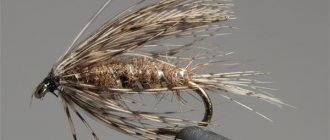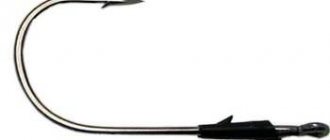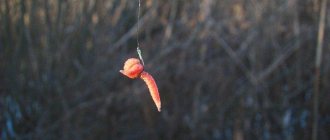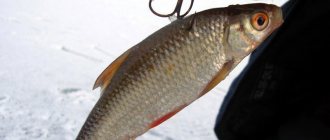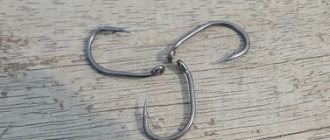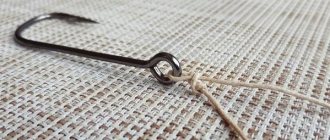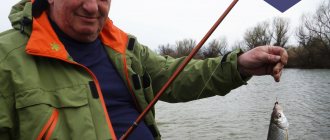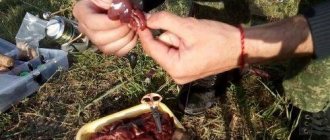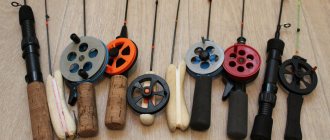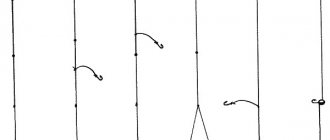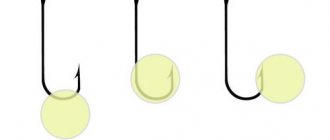Fishing hooks must be selected based on the size and type of bait and the following criteria:
- The smaller the bait, the smaller the hook;
- Hooks made of thin wire are used when using delicate and soft baits, such as bread, but if a large fish is caught, there is a chance that it will bend it and break off;
- Thick wire hooks are suitable for strong and strong bait, they are difficult to put on soft baits, but they can withstand large fish;
- Vegetable baits such as pasta, pearl barley, corn and others should completely cover the hook tip. When using animal baits, the hook tip may protrude.
- There are additional requirements for carp hooks; read about this in the article How to choose carp hooks.
Long shank hook
Forend length
Depends on the type of fish:
- If the fish actively bites and greedily grabs the bait, it is necessary to use a long fore-end, this allows you to quickly and conveniently remove it from the hook and continue fishing further; such hooks are used by athletes in competitions;
- If the fish is not active or bites rather slowly and sluggishly, for example carp, the shank should be short, the fish movement will be minimal and the strength of the hook will increase;
- Vegetable baits should be used on hooks with a short shank, and animals, on the contrary, on hooks with a long shank;
- When fishing from the bottom, the length of the forend is not important; it is more convenient to use a short forend.
Main selection criteria
Any tackle requires the presence of a fishing hook.
To choose the right hook for crucian carp, you should consider the following factors:
- crucian carp size;
- type of gear;
- bait;
- type of reservoir.
To be well versed in the variety of hooks, you need to know the terminology.
So, the hook is distinguished:
- head (place of attachment to the fishing line);
- forend (from the head to the beginning of the curve of the hook);
- sting (consists of a point and a beard);
- prying (the rounded part from the end of the forearm to the sting);
- pharynx, or width (distance from the sting to the forend).
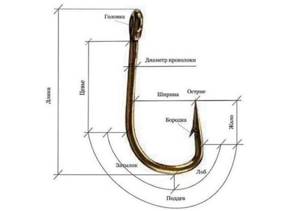
It is these characteristics that determine its intended purpose.
Size
There are different options for dimensional grids for hooks:
- domestic;
- international;
- Finnish;
- Japanese
The classification of sizes may also depend on parameters such as the width of the throat, the length of the forend, etc.
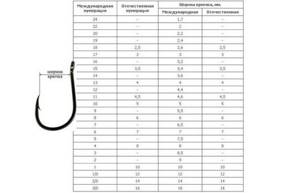
Correspondence table between international and domestic hook numbering
In this case, when going for crucian carp, you should know that the peculiarity of this fish is its small mouth, with which the crucian carp seems to suck in the bait rather than swallow it. Therefore, a small hook is needed for it.
Handguard
There are several types of hooks:
- with standard handguard;
- with an extended forearm.

To catch crucian carp, the shank of the hook must be of a standard size.
Material
Crucian carp is a cautious fish, so the hook for it is:
- should not shine so as not to scare away the fish;
- should not be too thick, otherwise the crucian carp simply will not be caught;
- must be strong enough not to break under the weight of the crucian carp.
Therefore, the material is additionally treated high-carbon steel, which is subsequently coated with NB-black nickel.
Thickness
The thickness will also depend on the type of bait. If you prefer to fish with a maggot or bloodworm worm, it should be thin. When using corn, for example, the thickness should be correspondingly greater.

Acuity
To catch crucian carp, the hook must be perfectly sharp. You should check the sharpness in the store when purchasing. To do this, run the sting along the pad of your finger.
Important! Don't test the sharpness by rubbing the sting on your nail, otherwise you'll dull it in the store.
The sharp sting seems to stick to the skin.
If the hook becomes dull, it can be straightened with fine sandpaper. Some fishermen advise using a phosphorus strip on a box of matches for this purpose.
Form
The shape of the hook depends on the type of tackle and bait. So, for a float fishing rod they take the “classic” version with a straight thin tip. But the bottom version should have an internal bend of the tip.
Based on the type of bait, there are also some subtleties here. So, for a worm you can use a long shank and a small pharynx, but for dough or bread you need a different shape: a short shank, a wide pharynx.
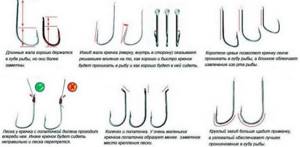
Effect of using different shapes of hooks
Diameter of wire hooks
- The larger the fish, the thicker the wire from which the hook is made should be so that it cannot bend it and break;
- Hooks made of thin wire are convenient and easy to put on soft and delicate baits, but large fish easily unbend them. Thick wire hooks are problematic to use with delicate baits.
When catching fish with a worm or maggot, hooks made of thin wire allow you to carefully pierce them through the skin, and they will be alive for a long time.
When using pearl barley or corn, putting it on a thin hook, they will constantly fly off when casting.
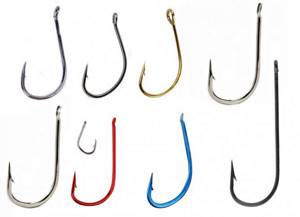
Hooks with different bends
How to choose a crochet hook
Structure of a crochet hook
But before we start learning how to select a hook for yarn, we need to understand the appearance of the hook. The base of the hook, its handle, is called the shank. An end with a hook - a head. And the hooking, working part of the hook is the barb.
When choosing a hook, always pay attention to the sharpness of its head. If it's too sharp, you risk cutting your fingers when knitting. But a head that is too round is also not good: it is difficult to knit with such a crochet hook, it is difficult to insert it into the loops. What kind of head should the hook have? Ideally - in the form of a rounded cone.
Are hooks with handles convenient? Only for those who have been knitting for a long time. For a beginner knitter, such a hook is hardly suitable. Since your handwriting in this art form has not yet developed, you need to feel whether you are pulling the loop tightly or weakly. And the knob reduces sensitivity.
What are the best crochet hooks: select the hook according to the material
However, it is not only the structure of the hook that makes the choice difficult. The store has all kinds of hooks: here you can find wood, plastic, and metal! How do they differ from each other? And what are the best crochet hooks?
Steel hooks are the most practical and convenient. They last a long time and can be used for any yarn.
Aluminum hooks are also comfortable, and what’s nice when knitting for a long time is that they are very light. Although they also have disadvantages: they often stain light-colored knitting, the fingers of the craftswoman, and if the knitting is too hard, such a hook can even bend.
Plastic hooks are cheap, light and very convenient, they do not hurt your fingers. They have only one drawback - they can electrify the yarn. But if you like the plastic hook, just spray it with an antistatic agent to remove this drawback. Important: when choosing a plastic crochet hook, you need to make sure that it is not too flexible.
Wooden hooks are very beautiful, light and environmentally friendly. But they are not very practical: they become electrified and quickly become covered with burrs, which catch the thread and interfere with knitting.
Bone hooks are an ideal option for knitting from natural wool. But these hooks are quite expensive, and also fragile.
How to choose a hook for yarn?
But neither the material, nor even a comfortable hook head has as much influence on the beauty of your knitting as the correct choice of hook for the yarn. You can see for yourself: there are thin hooks, and there are thick ones. It is clear that thick yarn requires a thick hook, but which one?
How to choose the right crochet hook for beginners? The easiest way is to use the manufacturer's hint. Typically, on skeins of yarn, manufacturers indicate which hook and needle numbers are suitable for each specific yarn. But what if there is no such indication? Then what should we do?
And in this case, there is a simple method that is suitable for a beginning craftswoman. All you need is your hooks and the thread you like. Hook the thread and watch carefully.
If the thread is easily picked up by the hook, and the barb protrudes above the thread, then the hook is too thick. If the beard is not visible at all because of the thread, the hook is too thin. Which hook is suitable? The one whose beard will be flush with the thread when hooked.
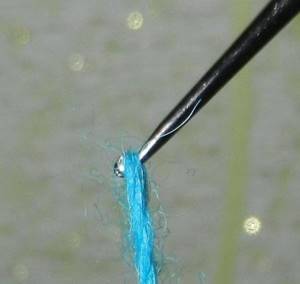
If you don't have the opportunity to carry all your hooks with you, you can simply remember their numbers and rely on the method of measurement. The fact is that the hook number is the thickness of its working part. That is, hook No. 2 has a working part thickness of 2 mm. Experienced craftswomen believe that the thickness of the yarn should be 1 mm less than the thickness of the hook - in this case, the knitting will be even and beautiful.
But what about an online store? If you want to buy a crochet hook online, store managers will always help you. Knowledge about the features of choosing crochet hooks, as well as professional advice from consultants, will help you choose the ideal hook for your work.
On our website you can also read about the selection and types of yarn for knitting.
Hook Bend
The greater the bend of the hook, the more baits you can put on it.
Hooks with a wide bend are more suitable for using plant baits.
For animal baits, hooks with a short bend are more suitable.
From personal observations, fish bite more actively on hooks with a narrow bend, which is probably more difficult for them to feel.
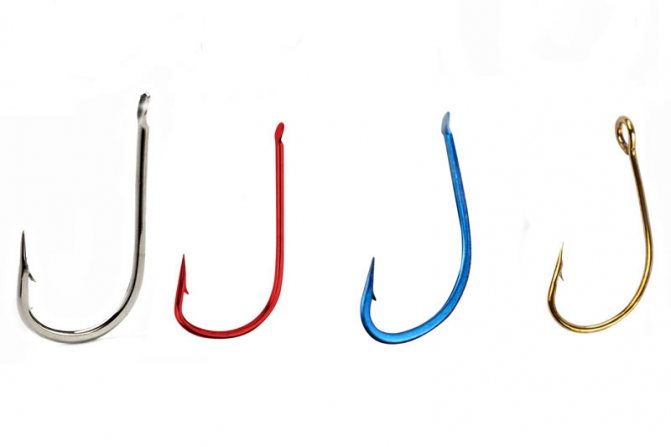
Colored fishing hooks
Shapes of carp hooks
To catch one of the most “sporty” freshwater inhabitants, more than one type of fishing hook is used, and this is due, first of all, to the variety of equipment used for catching cyprinids. What features and advantages does each type of fishing hook have in carp fishing? Let’s look at it below.
Hook with inward eye
This is what this type of hook looks like
What is special about this form? Firstly, it is the most common solution when preparing most carp rigs, and secondly, such a hook is an aggressive comrade that perfectly detects fish, thanks to its ability to turn around when the fishing line is pulled and firmly cling to the lip of the prey. However, they have one drawback - due to their “agility”, when fishing for carp, they greatly tear up the place of the hook, increasing it, which often leads to the fish moving away, since the hook simply slips out.
3.2 Hook with an eye bent back
In the windows of fishing stores you will find a carp hook of this shape
You will need a hook with such an eye “turned” in the opposite direction if you are using a rigid (steel) leash, so that when it hits the bottom of the reservoir, it remains in its unchanged position, namely at the correct angle of attachment to the bait and all other equipment. In this position, the delicacy offered to the carp looks most presentable, which it will not be able to refuse and will not vomit when tasting it.
Hook with straight eye
Most likely, you will not find such hooks in carp anglers’ rigs. They are simply not used by them. However, let's look at their features. Their main purpose is to catch large trophies in the upper layers of water. The difficulty of their practical use is that you have to constantly control the position of the hook, so that it is always on the back side of the nozzle, so that the fish swimming up from below simply does not notice it.
If you use a heat-shrink tube, the ability to accurately detect prey on this hook will increase significantly. This tube must be bent so that the hook faces its end. But the disadvantage of this maneuver is that everything takes time and the result is a rather inconvenient design.
Hook with a long and inwardly curved shank
These hooks are often called "banana" hooks due to their shape. Doesn't it really look like this fruit?
They are among the effective forms of carp fishing hooks.
Their advantage is the ability to easily rotate on the equipment, which facilitates quick notching in the inside of the oral cavity.
Area of application : catching large and cautious representatives of the carp dynasty.
The equipment is short leashes made of soft material, which smoothly sink to the loaded bottom of the reservoir.
The disadvantage is that they can greatly damage the oral cavity of the fish, for this reason many fishermen do not keep them in their arsenal.
Hook color
The color of the hooks is only important when fishing in clear water. You should not use colors that contrast with the background of the bait.
We recommend: How to put maggots on a hook
| Hook color | Where to use |
| Red Blue | With bright baits, such as bloodworms |
| Gold or silver | When fishing with light-colored bait, such as maggots, cereals |
| Black | When fishing in areas with a dark bottom |
How to choose the size
More often, beginners select hooks only based on size, and consider this the main factor when choosing. There is truth in this, but there are other factors. Different sizes are also needed if the fisherman wants to successfully fish. You can’t go to the store, pick up five medium-sized packs and assume that you’re covered for the season.
Taking into account various attachments and baits, types of fish, fishing conditions in different bodies of water. It is recommended to use hooks from 8 to 18 numbers during the season. Most often these are numbers 10, 12, 14 and 16 according to European qualification, when the higher the number, the smaller the hook. However, in some stores there is a situation where the smaller the number, the smaller the hook.
Numbers 14 and 16 are usually used for catching small fish with a feeder, for example, on a still body of water. Bloodworms attach well to such hooks and do not spread. These sizes of fishing hooks are suitable, for example, for catching roach with a feeder, bleak, and bream.
But number 18 is rarely used by beginners; more often it is used by athletes to catch small fish at speed. Not to mention number 20, which is no longer used by athletes so often.
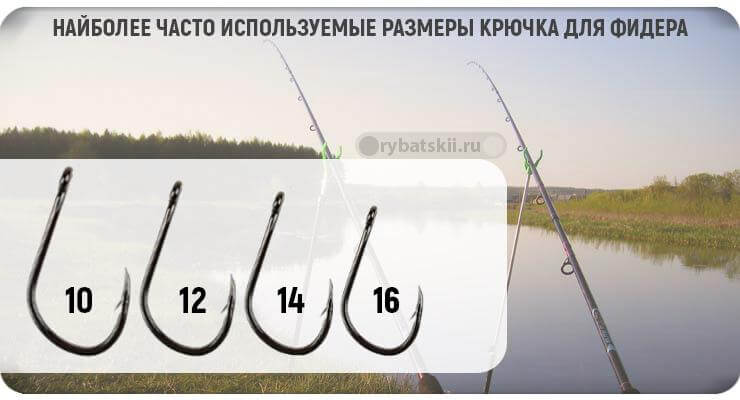
Numbers 8, 10 and 12 are already suitable for catching large fish such as bream, crucian carp, carp or chub. These sizes are already used more often when fishing with a feeder on the river, where the fish are larger and stronger. You can already attach baits such as a worm, maggot, peas, corn, and also make so-called “sandwiches”. For example, on number 10, 2–3 maggots and bloodworms are planted. On number 8 they already put several maggots and a worm or 2 parts of a worm, which can already attract large bream or other trophy fish. They can withstand the load when fishing for trophies. Unless, of course, it’s a Chinese fake that can be unbent by hand.
Bait and hook sizes
Hooks are always selected individually and at the fishing site; for a preliminary assessment, you can use the following data:
| Bait | Hook size |
| maggots, ant eggs, small larvae, flies; | 18 — 12 |
| suitable for earthworms, dungworms, large larvae; | 12 — 8 |
| corn, pearl barley, pasta | 14 — 8 |
